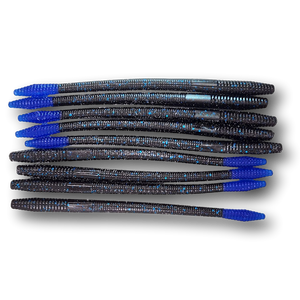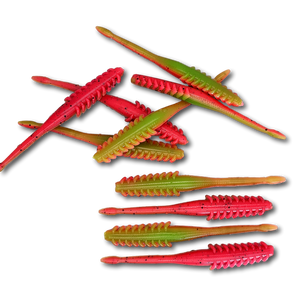
Four-Seven Lures 4 Inch Hex Worm Soft Plastic Bait
Four-Seven LuresCarolina Rig (light • 1/8–1/4 oz • 18–30″ leader)
When & where: Sand-to-gravel transitions and points with roaming smallmouth/spots.
How: Slow pull-pause; feed slack so the worm swims and settles horizontally.
Why: Covers water while keeping the segmented body breathing.
Drop Shot (nose- or wacky-hooked)
When & where: Vertical rock edges, shade lines, bridge corners, and FFS marks.
How: Hold in place with slack-line shakes; long pauses; occasional slow swim-backs along contour.
Why: Hex segments add micro-quiver at rest for pressured fish.
Hover Jig / Damiki (1/16–1/8 oz) — situational
When & where: Suspended fish around fry in 10–30 ft.
How: Level hover with tiny rod quivers; keep above eye line; count-down to depth.
Ned / Midwest Finesse (1/32–1/8 oz)
When & where: Clear to stained rock/gravel; post-front; pressured water.
How: Drag-drag-pause with micro shakes; deadstick to let the tail neutral-float.
Tuning: Trim 1/4–3/8″ from the nose for micro heads.
Neko Rig (1/32–3/32 oz nail)
When & where: Docks, bluff shelves, and transitions.
How: Short lifts that let the segmented body compress/expand; nose ticks bottom; O-ring improves durability.
Standard (Ball) Jig Head / Shaky (1/16–1/8 oz)
When & where: Banks and river seams; fish it like a tiny leech.
How: Crawl/creep; lift-drop to tick rock; pause to let the tail breathe.
Texas Rig (micro • 1/16–1/8 oz)
When & where: Docks, laydowns, and edges where open hooks hang.
How: Short pitches; semi-slack fall; shake to make the tail breathe; swim-and-kill along edges.
Wacky Jig Head
When & where: Calm marinas/overhangs; skip under shade.
How: 6–10″ lifts; pendulum on semi-slack; center an O-ring for hinge action.
Wacky Rig (weightless)
When & where: Ultra-clear pockets and spooky fish that react to silent entries.
How: Glide and twitch; long pauses; watch line for ticks.
Tuning & Mods (quick hits)
- Tail taper: Slight taper tightens quiver for cold water; leave full for warm water.
- Neko ring: 10–12 mm O-ring centered; rotate 90° for better hook geometry.
- Scent & keeper: Gel scent optional; tiny dot of glue at keepers extends life.
Naturals (Green Pumpkin / Browns / Mocha) — clear, sunny, pressured
- Why: Reads as leech/bug/craw fry without flash.
- Use: Ned/ball head on gravel; Neko around docks; drop shot on vertical rock.
Blood/Red/Purple family — dawn/overcast, wind over rock, pre-spawn
- Why: Hematite/red cues signal inverts and craw tones; stands out without gaudy flash.
- Use: Neko on gravel points; drop shot along rip-rap; Ned on chunk rock.
Dark / Silhouette (Black Sapphire / Junebug) — stain, mud, low light
- Why: Maximum contrast and line-watching bites.
- Use: Wacky/weightless under docks; Texas around grass with long pauses.
Hi-Viz (Bubblegum/Chartreuse variants) — sight-tracking, rivers, cold fronts
- Why: Lets you and the fish track the bait in stain or heavy glare.
- Use: Wacky/weightless for visual strikes; jig-worm when you need a confidence color.
- Length: 4.0" (101.6 mm)
- Profile: Hex-segmented straight-tail finesse worm; neutral-float quiver at rest
- Material: Soft plastic
- Best Pairings: Drop Shot (1/8–3/8), Ned (1/32–1/8), Standard Ball Head/Shaky (1/16–1/8), Neko (1/32–3/32 nail), Micro Texas (1/16–1/8), Light Carolina (1/8–1/4), Wacky/Weightless
- Hook Sizes: Wacky #1–1/0 (O-ring), Texas 1/0–2/0 EWG or finesse straight-shank, Ned/ball heads #2–1, Neko #1–1/0
- Species: Bass (LM/SM/Spots); walleye/trout selective on light heads
- Availability: Ships promptly when in stock.
Care & Storage
Store flat in the original bag. Separate darks/lights to prevent dye bleed. Avoid prolonged heat to preserve tail memory.
Plastics Recycling
Don't toss torn baits—recycle or dispose of properly. Learn more here: Soft Plastics Recycling.
On-the-Water Notes
- Cold fronts: Drop shot/Ned with long deadsticks; most bites on slack while the segments breathe.
- Shade lines & docks: Wacky (weightless or 1/16 oz head); skip and pendulum back on semi-slack.
- Wind on rock: Neko with 1/32–3/32 oz nails; pause after a deflection and watch the line jump.
Q&A
Q: Why a hex-segmented worm over a smooth finesse worm?
A: The segmented body compresses/expands on micro-moves, adding vibration and a neutral-float “leech” look that convinces pressured fish.
Q: What’s the best all-around setup?
A: 6’10″–7’2″ ML spinning, 8–15 lb braid to 6–10 lb fluoro leader; pick weight so it stays level, not nose-down.









